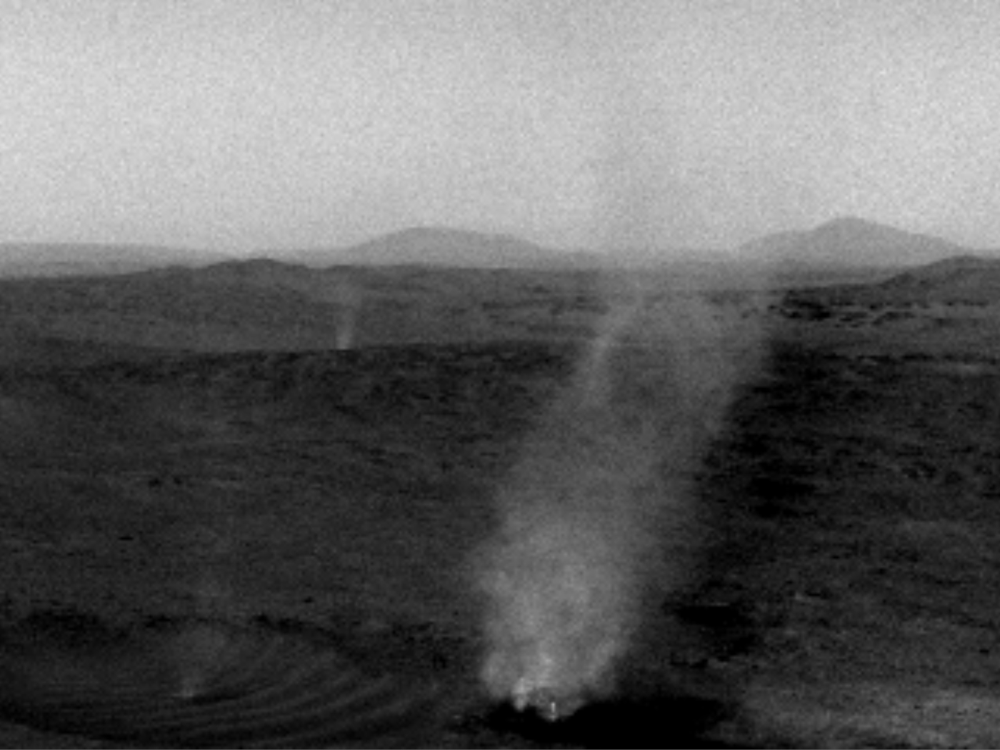Watch a Spinning Martian Dust Devil 'Consume' Another in a New Video Captured by NASA's Perseverance Rover
Watch a Spinning Martian Dust Devil ‘Consume’ Another in a New Video Captured by NASA’s Perseverance Rover
Tracking dust devils helps researchers learn more about Mars’ atmosphere, wind and weather conditions
NASA’s Perseverance Mars rover spotted a large dust devil (on the right) consuming a smaller, fainter twister (on the left in the foreground).
NASA / JPL-Caltech / LANL / CNES / CNRS / INTA-CSIC / Space Science Institute / ISAE-Supaero / University of Arizona
NASA’s Perseverance rover has captured a Martian atmospheric phenomenon reminiscent of the mischievous, spinning Tasmanian Devil from Looney Tunes. The new visuals show a dust devil consuming a smaller one on the rim of the red planet’s Jezero Crater.
“These mini-twisters wander the surface of Mars, picking up dust as they go and lowering the visibility in their immediate area,” Mark Lemmon, a Perseverance scientist at the Space Science Institute, says in a NASA statement. “If two dust devils happen upon each other, they can either obliterate one another or merge, with the stronger one consuming the weaker.”
Perseverance spotted the swirling winds with its navigation camera on January 25 while exploring a location on the crater’s western rim called Witch Hazel Hill. At about 0.6 miles away from the twisters, the rover snapped photos as a roughly 210-foot-wide dust devil pulled in a smaller and fainter 16-foot-wide one. NASA compiled Perseverance’s images of the event into a short video.
A Martian dust devil consumes a smaller, fainter one moving to the left of it, as other twisters spin in the distance.
NASA / JPL-Caltech / LANL / CNES / CNRS / INTA-CSIC / Space Science Institute / ISAE-Supaero / University of Arizona
Dust devils occur when air heated by Mars’ ground rises through the denser, cooler air above it, and surrounding air moves in to take its place. This incoming air begins to rotate and rise into a column, picking up speed—similar to how a spinning ice skater moves faster by bringing their arms closer to their body, according to NASA. The rotating air drags up dust into its twister, redistributing it around the planet.
“Dust devils play a significant role in Martian weather patterns,” Katie Stack Morgan, project scientist for the Perseverance rover at NASA’s Jet Propulsion Laboratory, says in the statement. “Dust devil study is important, because these phenomena indicate atmospheric conditions, such as prevailing wind directions and speed, and are responsible for about half the dust in the Martian atmosphere.”
While it might feel natural to compare Mars’ dust devils to Earth’s tornadoes—or the twister in The Wizard of Oz—Martian whirlwinds are not nearly powerful enough to lift up much of anything, let alone a farmhouse. “The Martian atmosphere is so thin that it would feel like a gust of wind,” atmospheric scientist Priya Patel explains in a NASA video. “Though, you’d get pretty dirty.”
Perseverance Rover Captures Dust Devils Whirling Across Mars (Mars Report)
Watch on
According to a recent study, however, Martian dust could cause serious hazards for future astronauts: namely, respiratory health issues. “The dust really does get everywhere, and it behaves a bit differently to dust on Earth,” where the particles get smoothed down over time, says Julia Cartwright, a planetary scientist at the University of Leicester in England who didn’t participate in the study, to CNN’s Jack Guy.
On the moon and Mars, dust particles are very sharp. “This is a problem if they are in the air that you are breathing—sharp particles are more likely to cause irritation to soft membranes, which is where you can run into issues with your lungs,” Cartwright adds.
Martian dust has already caused problems on uncrewed space missions. Notably, a 2018 dust storm permanently shut down NASA’s Opportunity rover after covering its solar panels with grit. The agency’s InSight lander met a similar fate in 2022. Both Perseverance and NASA’s Curiosity rover were designed with a nuclear power source, which help them fare better in such dust storms, per Forbes’ Amanda Kooser.
The recent dust devils are just two of many that Perseverance has captured since landing on the Red Planet in 2021, and it has even recorded the sound of a dust devil. In 1997, NASA’s Pathfinder mission was the first to capture photographs of dust devils from the ground. Further studies of these dust devils and Martian dust in general could help inform NASA as it strives for its goal to send humans to Mars as early as the 2030s.
Get the latest stories in your inbox every weekday.


